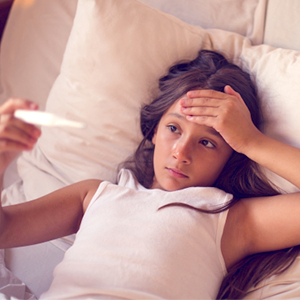How did your parents treat your fevers when you were younger? Did they use
cold washcloths and a variety of herbal remedies, or-like mine-some
fever-reducing medicine and the occasional 7-UP? Now that we’re
the parents, we want to make sure our children get the best treatment
possible.
This simple list takes the guesswork out of treating a fever:
-
Do give them fever-reducing medicines, like
Tylenol and Motrin, but stick to one at a time. -
Don’t give them aspirin, which can be toxic in
children under 18. -
Do remove extra layers of clothing.
-
Try to keep them hydrated.
-
Don’t over-bundle babies or cover children with
extra blankets. -
Do apply cold compresses.
-
Try a lukewarm bath.
-
Don’t put them in ice cold or alcohol baths.
Everybody knows about acetaminophen (Tylenol and others, abbreviated
“APAP”) and ibuprofen (Advil, Motrin and others, abbreviated “IBU”). These
are the mainstays of fever-reducing medicines, and can be used in babies.
APAP can be used in children over 3 months old and IBU can be used in
children over 6 months old. If your less than 3 months old has a fever,
please call your pediatrician right away for guidance on a game plan that
may involve some lab work. Fever in this age group can indicate a serious
infection, and we don’t take it lightly. But in older children, reducing
the fever with these medicines won’t necessarily make the underlying cause
of the fever go away faster, but it will make a kid feel more comfortable
and do a better job hydrating during the illness. Fluid losses increase
during the febrile state, so added hydration on top of what is normal is
critical.
Recall that nearly all medicines in children are dosed based on a
child’s weight in kilograms, so knowing a relatively accurate weight on
your child is important in this scenario.
Read the labels closely because APAP and IBU are dosed differently. And in
the spirit of accuracy, please use a syringe to measure in cc’s or ml’s,
not teaspoons. APAP can be given every 4-6 hours and IBU should be given
every 6-8 hours. One medicine that we are NOT going to use at all is
aspirin. Aspirin is a dangerous and toxic medicine for children younger
than 18 years old as it is associated with the neurologically devastating
Reye’s syndrome. Don’t even. Not one dose.
That’s really it on the medicines for fever. So what about all the rest of
it? As far as clothes and layers and blankets go, a balance needs to be
struck between roasting and freezing. In the febrile state, the body’s “set
point” is elevated, so the temptation is to add more layers because a
person with a fever often feels cold. And everyone thinks that little
babies need to be bundled up in 25 layers even when they don’t have a
fever. But the last thing we want to do is ADD to an already high
temperature, so many people do the opposite and remove everything. Then
shivering starts, which unfortunately is the body’s natural attempt to
raise the temperature as well. So somewhere in between lies the right
amount of lightly layered skin covering that will neither cause the child
to shiver nor will directly increase the body temperature. This sometimes
requires a little experimentation, since everyone is different.
Let’s move on to baths, washcloths and compresses.
Same as above, the goal is to cool the body without causing
shivering so that the internal temperature set point comes down. Using
common sense, that means a cold bath or ice bath is NOT a good idea.
Additionally, I’m not aware of a single soul on earth who thinks it’s
comfortable, and this whole post is about bringing down a fever to increase
comfort, right? So avoid the cold baths. A lukewarm bath or compress,
however, can be effective at helping the body cool down without overcooling
enough to cause shivering. If a bath sounds perfectly awful to the sick
person, using cool (not cold) or lukewarm compresses in the areas where the
body typically loses heat can work well. These areas include the head,
armpits, groin and feet.
Alcohol baths seem to be a popular folk remedy, and I’m giving it its own
short paragraph because I want to be clear that we shouldn’t do this. Not
only can alcohol be extremely irritating to the skin, especially sensitive
young skin, it can be toxic if ingested so it’s really best to avoid this
method as a fever-reducing therapy.
I want to close by reminding everyone that it’s important to seek
medical care right away if you notice:
-
Fever and difficulty breathing
-
Fever and mental status/sustained behavioral changes
-
Fever and rapidly-evolving purple rash
Fever makes many people feel terrible, weak, and tired. Try a few
interventions from Category A and definitely the hydration part of Category
B, and hopefully you will achieve at least enough fever control to make you
or your little one feel a little less terrible during the inevitable
illnesses that we all encounter along life’s way.


